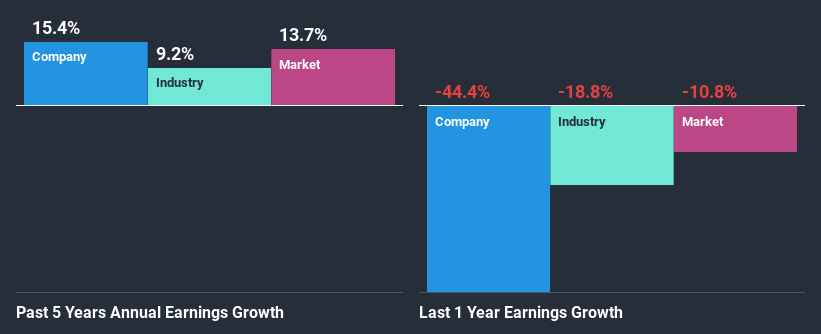Are Schaeffler India Limited's (NSE:SCHAEFFLER) Fundamentals Good Enough to Warrant Buying Given The Stock's Recent Weakness?
With its stock down 7.7% over the past month, it is easy to disregard Schaeffler India (NSE:SCHAEFFLER). However, the company's fundamentals look pretty decent, and long-term financials are usually aligned with future market price movements. Particularly, we will be paying attention to Schaeffler India's ROE today.
Return on Equity or ROE is a test of how effectively a company is growing its value and managing investors’ money. Put another way, it reveals the company's success at turning shareholder investments into profits.
See our latest analysis for Schaeffler India
How Do You Calculate Return On Equity?
ROE can be calculated by using the formula:
Return on Equity = Net Profit (from continuing operations) ÷ Shareholders' Equity
So, based on the above formula, the ROE for Schaeffler India is:
7.4% = ₹2.1b ÷ ₹29b (Based on the trailing twelve months to June 2020).
The 'return' is the profit over the last twelve months. That means that for every ₹1 worth of shareholders' equity, the company generated ₹0.07 in profit.
What Has ROE Got To Do With Earnings Growth?
So far, we've learned that ROE is a measure of a company's profitability. Based on how much of its profits the company chooses to reinvest or "retain", we are then able to evaluate a company's future ability to generate profits. Assuming all else is equal, companies that have both a higher return on equity and higher profit retention are usually the ones that have a higher growth rate when compared to companies that don't have the same features.
Schaeffler India's Earnings Growth And 7.4% ROE
It is quite clear that Schaeffler India's ROE is rather low. An industry comparison shows that the company's ROE is not much different from the industry average of 8.7% either. As a result, Schaeffler India's decent 15% net income growth seen over the past five years bodes well with us. Given the low ROE, it is likely that there could be some other aspects that are driving this growth as well. For example, it is possible that the company's management has made some good strategic decisions, or that the company has a low payout ratio.
We then compared Schaeffler India's net income growth with the industry and we're pleased to see that the company's growth figure is higher when compared with the industry which has a growth rate of 9.2% in the same period.

Earnings growth is a huge factor in stock valuation. It’s important for an investor to know whether the market has priced in the company's expected earnings growth (or decline). This then helps them determine if the stock is placed for a bright or bleak future. Is Schaeffler India fairly valued compared to other companies? These 3 valuation measures might help you decide.
Is Schaeffler India Efficiently Re-investing Its Profits?
Schaeffler India has a low three-year median payout ratio of 22%, meaning that the company retains the remaining 78% of its profits. This suggests that the management is reinvesting most of the profits to grow the business.
Moreover, Schaeffler India is determined to keep sharing its profits with shareholders which we infer from its long history of paying a dividend for at least ten years.
Conclusion
Overall, we feel that Schaeffler India certainly does have some positive factors to consider. Even in spite of the low rate of return, the company has posted impressive earnings growth as a result of reinvesting heavily into its business.
If you decide to trade Schaeffler India, use the lowest-cost* platform that is rated #1 Overall by Barron’s, Interactive Brokers. Trade stocks, options, futures, forex, bonds and funds on 135 markets, all from a single integrated account. Promoted
New: Manage All Your Stock Portfolios in One Place
We've created the ultimate portfolio companion for stock investors, and it's free.
• Connect an unlimited number of Portfolios and see your total in one currency
• Be alerted to new Warning Signs or Risks via email or mobile
• Track the Fair Value of your stocks
This article by Simply Wall St is general in nature. It does not constitute a recommendation to buy or sell any stock, and does not take account of your objectives, or your financial situation. We aim to bring you long-term focused analysis driven by fundamental data. Note that our analysis may not factor in the latest price-sensitive company announcements or qualitative material. Simply Wall St has no position in any stocks mentioned.
*Interactive Brokers Rated Lowest Cost Broker by StockBrokers.com Annual Online Review 2020
Have feedback on this article? Concerned about the content? Get in touch with us directly. Alternatively, email editorial-team@simplywallst.com.
About NSEI:SCHAEFFLER
Schaeffler India
Engages in the development, manufacture, and distribution of high-precision roller and ball bearings, and related components worldwide.
Flawless balance sheet established dividend payer.
Similar Companies
Market Insights
Community Narratives



